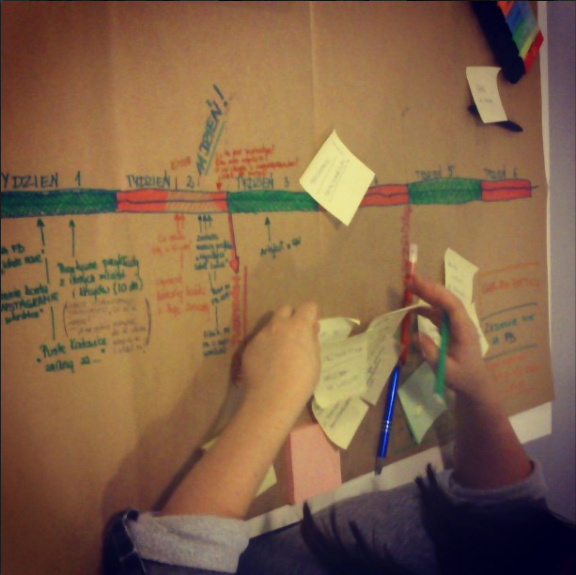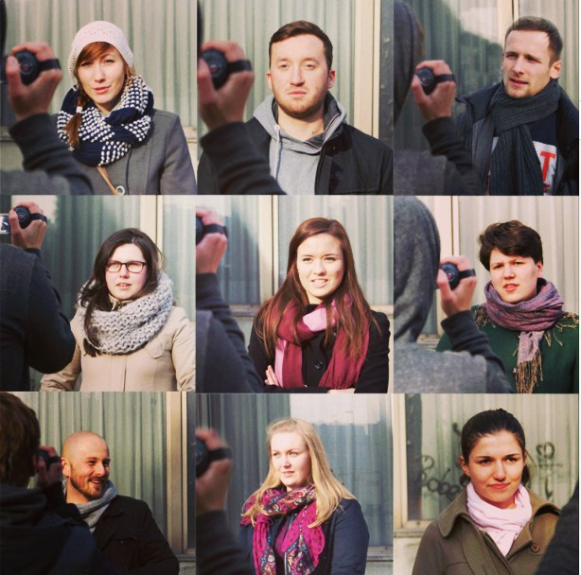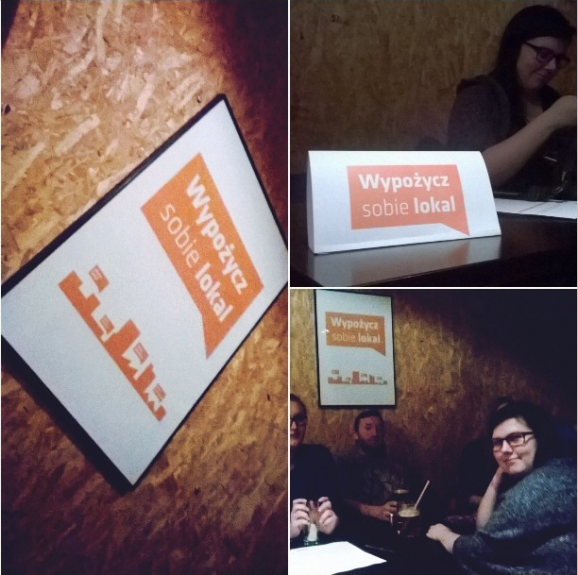All along the year 2017, Saint-Etienne has lived under the rhythm of Human Cities_Challenging the City Scale.
Saint-Étienne has got a distinctive feature of a creative laboratory, where hands-on stakeholders develop methodologies and actions with the communities to transform the city. That’s why the Cité du design, leader of the project Human Cities Challenging the City Scale in Saint-Etienne has created C.H.O.S.E (Collective Humancitizens Office of St Étienne Experimentations), a tool to stimulate and connect these local energies and creative forces.
Within this framework, Ici-Bientôt multidisciplinary group was launched to revitalize a commercial street in the old town.
ICI-BIENTOT (“COMING-SOON”)
Ici-Bientôt is a collective constituted for Human Cities experimentations in Saint-Etienne, to find solutions against the increase of vacant shops and breathe new life into the changing neighbourhood “Beaubrun Tarentaize” . Its main coordinators : CREFAD Loire, an association of long-life learning and capacity building, and Typotopy, a collective of graphic designers, together with a working group of cultural, community associations and residents of the neighbourhood.
Ici-Bientôt is multifaceted: it’s a place, a project and a group population; it’s a synergy between actors (project leaders, owners, associations, institutions…) to find solutions create tomorrow’s urban lifestyles.
Its actions are complementary . Ici-bientôt worked on the history of the districts and its multicultural population ; they opened a resource center, supporting people with projects to set up in vacant premises ; they transformed shop windows and signs of closed or active shops, and they invested the public spaces with artistic installations and performances. Their purpose: to increase the knowledge about the resources of the district, the dialogue and autonomy amongst their stakeholders. For that, they used mapping, interviews, music events, thematic workshops, business support, and a daily presence in the resource center from June 2016.
Mathilde Besse, who works for the Crefad, the main coordinator of Ici-Bientôt, explains one tool used to collect people feelings about a collective question : “the word holder”
During the Biennale Internationale Design Saint-Etienne 2017 ( 9th March-9th April 2017) , Ici-Bientôt helped the set-up of 5 temporary boutiques to test a professional, commercial or non profit activity, involving 30 people: a bar, a collective shop for craft designers ; an associative tea-room animated by volunteer mums of the neighbourhood ; a place dedicated to activities on reading and writing ; a visual and sound exhibition room. Restoration works with 30 volunteers from the neighbourhood helped to renovate the shops and injected a collective energy. Artistic interventions, performances and parties invited people to give a new life to the street. 150 people enjoyed the opening day in Rue de la Ville. Roundtables and workshops allowed the exchanges about the issues of vacant shops and transformations of work paradigms (the theme of the 2017 Biennial) During the last week of the Biennial, pupils from a professional high school worked with Polish graphic designers to offer new signs to 3 active shops in the upper end of the street.
International guests gave new inspirations and ideas. The workshop with the partners from the European project Human Cities_Challenging the Ciy Scale confirmed some intuitions or enlarged the perspectives about the re-activation of vacant shops. A roundtable with designers and activists from Detroit, the UNESCO City of Design guest of Honour of this Bienniail, allowed a fruitful exchange about leisure, work, and community building with the members of the collective.
After this extremely rich period of events, the activities of Ici-Bientôt got back on the support of project holders, mainly with the action of CREFAD Loire, which office is now in the resource centre. The 5 temporary boutiques closed, but 1 permanent opened in October 2017, with the help of Ici-Bientôt. Thanks to their support to build her business and renovate a vacant shop, Souad, a seamstress, opened a shop proposing sewing and embroidery works and activities and her fashion creations. A shared workshop space and craft lab will open for 6 months. 5 new shops will have new signs made by Typotopy.
Moreover, the Ici-Bientôt group is now associated to the working group of institutions, urban planners, and developers working on the renovation projects of the neighbourhood. They have been hired for their expertise and daily observation of the dynamics at the micro-scale of the district. Amongst the coming projects they are contributing to a new center for music and dance amateur practices ; a urban projects center and an action to support new entrepreneurs.
Of course it will happen Ici (here), bientôt (soon).
A social campaign for the return of empty buildings in Katowice city centre to urban life in Katowice, Poland
Fundacja Napraw Sobie Miasto (“Fix Your City” Foundation) addressed the issue of empty buildings in 2013, during the realisation of the project Vacant Central Europe: Mapping and recycling empty urban properties. This is when we mapped the empty properties from the social point of view and searched for ideas how to utilise them temporarily and permanently. In 2014, we took special interest in a particular object: the seat of Pracownia Projektów Budownictwa Ogólnego (General Construction Projects Studio) in the district of Koszutka, which used to be run by Henryk Buszko and Aleksander Franta, the authors of the legendary icons of modernism: Osiedle Gwiazdy (“Stars” housing estate) and Osiedle Tysiąclecia (“A 1000 years anniversary” housing estate) in Katowice as well as the health resort in the town of Ustroń. Moreover, we asked various people whether they knew any abandoned places in the city which could be used as interesting exhibition or theatre spaces. While seeking inspiration for a way to regulate the use of such places in the future, we came across a similar programme working in Warsaw. We started monitoring and assessing its effects.
Working on the Rent the Place DIY project we prepared the second edition of a spatial database and maps based on the detailed information obtained from Katowice City Hall. At the same time, we realised that the issue, however important, was barely present in the public debate, which was why we launched the social campaign. Therefore, the goal of our action is to draw the attention of the residents and users of Katowice urban space to the problem of vacant buildings, to promote the idea of the temporary use of uninhabited properties, and to generate and test the ideas for their reuse. This is the reason why we are running the informational campaign, building social support for the proposed legal solutions, collecting signatures under a petition, networking potential renters of the empty buildings, and organising workshops to demonstrate the possibilities of their adaptation.
Video: https://www.youtube.com/watch?v=nhvLum9GCs8
-Key-actors
Role of design
The whole project was run iteratively, and the idea emerged in the course of consecutive stages of development. After the completion of each stage, we organised retrospective workshops at which we verified and reformulated the adopted solutions and developed the rules for the invitation of new partners. This was why changed our initial idea.
The concept of the legal regulations was prepared according the service design method during a meeting of the project team. The social campaign and the action promoting the short-term rental of empty premises were developed in a workshop manner (co-design).
CONTACT
Organization: Fundacja Napraw Sobie Miasto
Email : agata.janko@naprawsobiemiasto.eu – kontakt@naprawsobiemiasto.eu
wep page: http://naprawsobiemiasto.eu/



Since 2014, the Human Cities network has been working on Challenging the City Scale to question the urban scale and investigate cocreation in cities. The Human Cities partners have carried out urban experimentations in 11 European cities empowering citizens to rethink the spaces in which they live, work and spend their leisure time.
Challenging the City Scale, journeys in People-Centred Design is the final book of the project. Through conversations with people involved, the book examines how bottom-up processes and their design, tools and instruments generate new ideas to reinvent the city. It offers inspiration and insights to everyone, from practitioners and politicians to designers and active citizens, eager to try out new ways to produce more human cities together.
Title : Challenging the City Scale, Journeys in People-Centred Design
Collective book co-edited by: Olivier Peyricot, Josyane Franc, Frank Van Hasselt
Authors: Josyane Franc, Olivier Peyricot, John Thackara, Alice Holmberg, Côme Bastin, Fleur Weinberg, Anya Sirota, Frank Van Hasselt, Robin Houterman
Graphic design: Audrey Templier, Isabelle Daëron Language: English Publisher and distributor: Birkhäuser, Basel
Co editors : Cité du design (Saint-Etienne) et Clear Village (Londres) ISBN: 978-3-0356-1796-2 Format : 21,5 x 26 cm (vertical)– 176 p Price: 39.95 € Available in partner’s bookshops and bookshop distributed by Birkhäuser Open access digital version: https://www.degruyter.com/view/product/510323?format=EBOK
As cities organizations are facing major urban and technological transformations, European citizens are taking possession of their cities, collaborating or acting for its renewal. Which kind of tools are set up to think and produce the public space together? How to make these bottom-up initiatives sustainable?
Challenging the City scale 2014-2018 / Investigation is a collaborative research work of Human Cities project, made from more than 80 case studies collected by the partners in Europe. They tell about actions led by creative citizens to transform their urban environment. Researchers from Cité du design Saint-Étienne, the Department of Design of Politecnico di Milano and Urban Planning Institute of The Republic of Slovenia Ljubljana provide a state of the art of these initiatives. Analysing these multiple examples, they investigate how urban dwellers participate, get organized and collaborate with creative professionals to prototype more liveable cities.
This scientific work published by Cité du design Saint-Étienne is addressed to researchers, practitioners, but also developers or creative citizens.
Title: Human Cities / Challenging the City Scale 2014-2018 / Investigation Main authors: Cité du design Saint-Etienne: Isabelle Daëron, Floriane Piat & Eléa Teillier Design Departement, University Politecnico di Milano: Davide Fassi & Laura Galluzzo Urban Planning Institute of the Republic of Slovenia, Ljubljana: Matej Nikšič, Nina Goršič & Biba Tominc
Language: English Copyright © Cité du design, 2018 ISBN: 978-2-912808-79-0 . Format : 215×260 mm – 240 p – not sold – free distribution within the framework of Creative Europe Programme of the European Union 2014-2018
In September 2018, all the European partners of Human Cities_Challenging the City Scale were invited to present the project in a conference and exhibition Human City Design co-curated by the Cité du design Saint-Etienne, the Seoul Design Foundation and Nagoya UNESCO City of Design.
The aim: initaiting a cooperation network in Asia, inspired by the European project.
Since then, the City of Seoul and Seoul Design Foundation have been committed into promoting the initiatives reflecting the issues of Human Cities. That’s why the Seoul Design Foundation has launched a Human City Design Award 2019 , in partnership with Saint-Etienne and Nagoya UNESCO Cities of Design. This award is meant to be global ; addressed to all the designers in the world involved in projects for more human and sustainable cities.
Theme: Design for Sustainable City for a harmonious relationship between human and the environment
Purpose:
Area: Projects that contribute to a more harmonious and sustainable relationship between people and people, people and society, people and the environment and people and nature
Qualification
Individuals or organizations who have five or more years of experience in design-related field and providing a recommendation letter from nations, local city governments, design-related universities or design-related associations
Award :
Grand Prize Money : 100 000
000 wons (KRW)
* worth à 85 000
US$ or 76 000 € (variable according to the rate of exchange)
Benefit Award and Grand Prize
Dates (Korean Standard Time)
Details of the call, Judging criteria, entry form and FAQ : www.humancitydesignaward.or.kr
Contact : humancity@seouldesign.or.kr
The Final Human Cities Challenging the City Scale 2014-2018 event will be held in Tallinn during XIII Tallinn Design Festival. In fact Human Cities is this year’s theme of the festival.
The XIII Tallinn Design Festival will be held from 10 to 16 September 2018. For a week, the unique festival which centres on different parts of Tallinn, will be revived – the historic Baltic Station Departure Pavilion, the new building of EAA, Museum of Architecte, Architectural and Design Gallery, Viru Centre, Telliskivi, Alexela Concert Hall, Solaris, Kadriorg Tennis Hall and dozens of satellites in various locations.
Designers, architects, urbanists, and planners are committed to ensuring a more sustainable and human-friendly urban environment. Insights and testimonials from other cities can be seen at exhibitions and the conference which marks the successful end of the four-year Europe-wide project “Human Cities – Challenging the City Scale”. We are looking forward to presenters from several architectural bureaus and other distinguished visionaries such as Mark Kingwell (Canada), Liam Young (UK) and Chantal Vanoeteren (Belgium). Those interested in urban development can see projects from 11 different countries, including innovative projects of Politecnico di Milano and Aalto University. The Estonian team will present the relaxation capsule HÄLO. The works of the nominees of Germany’s renowned design award IF will complement the exhibition from the perspective of the students. „Human Cities“, a music piece by Villu Veski and Laura will bring the project to an upstanding end.
This year’s design festival will be spiced by an exciting opportunity to get acquainted with the finest Estonian design in Viru Centre. At the festive Design Award gala product design awards BRUNO and SÄSI, graphic design award and prizes in other categories will be awarded.
A graphic designers exhibition „Dialogue“ will also be displayed.
Throughout September in the Museum of Estonian Architecture visitors can become acquainted with the exciting history of Isokon which has accrued from the foreign representation of the Luther factory. The text and pictures of the Isokon Gallery in London are supplemented by product examples from the Luther factory and its descendant, as well as replicas of the Isokon products, supported by the well-known designers from Bauhaus – Walter Gropius, Marcel Breuer, etc.
The exhibition reflecting the plywood industry is brought to the present day by the examples of the plywood manufacturer’s workshop. The topic is complemented by lectures of Jüri Kermik, John Allan and Magnus Englund (Director of the Isokon Gallery Trust). From Hungary, examples of wearable technologies and achievements of digital handicrafts are brought to the Design Festival. Authors are looking for answers on how a traditional craft can continue in today’s digital world without losing value. At the exhibitions of design schools one can examine the developments taken place in different educational institutions during the year, also get acquainted with the student works from Lahti and participate in an experience room Design For All. The festival’s attractions are fashion shows, PechaKucha and Design Street. The light installations show the way to the attractive centres of the Festival, a musician Kristjan Kannukene presents his new single in the tunnel. It is possible to participate at an unconventional tour „Closed Rooms“ and visit places full of surprises you could possibly not get into.
There will be plenty of events for the entire family, including educational workshops for children and workshops “Child Culture Design”